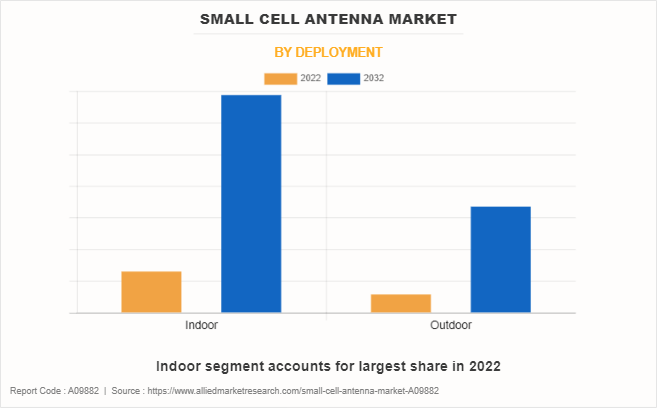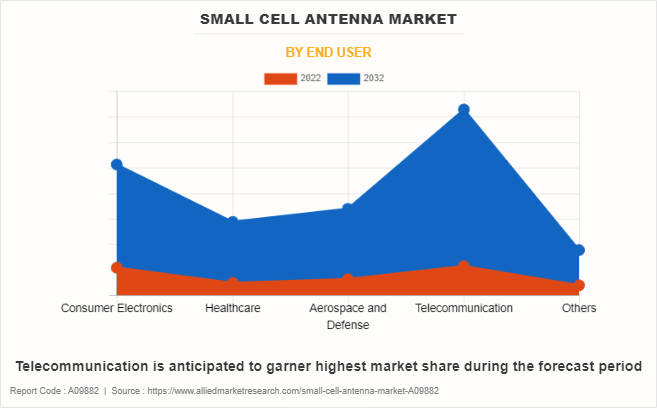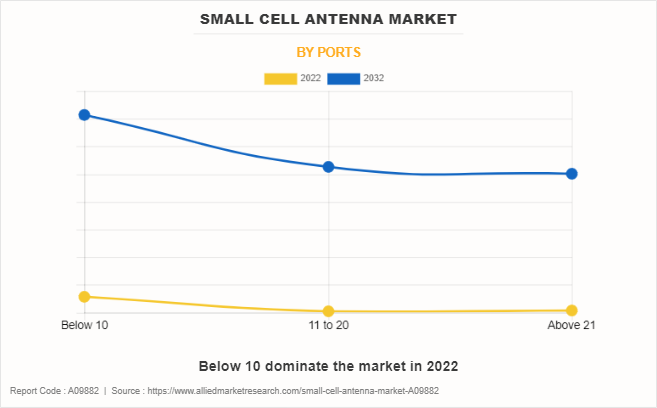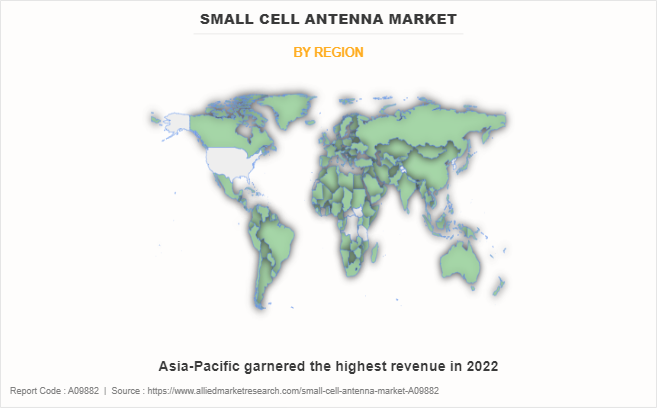Small Cell Antenna Market Research, 2032
The global small cell antenna market was valued at $1.9 billion in 2022, and is projected to reach $10.2 billion by 2032, growing at a CAGR of 18.8% from 2023 to 2032.
A small cell antenna is a small wireless communication device designed to increase network capacity and coverage in areas of high data demand. These antennas operate at lower voltages than conventional macrocells, making them suitable for densely populated urban areas. Small cell antennas are used in 4G and 5G small cell networks, small cells support seamless communication by transmitting data traffic from overloaded macrocell towers small cell antennas can be discreetly placed on streets over objects, buildings, and utility poles due to its compact size and unobtrusive design. This enables more efficient and targeted wireless signals, improving both network performance and user experience.

Segment Review
The small cell antenna market is segmented into ports, deployment, end user, and region.

On the basis of deployment, it is bifurcated into indoor and outdoor. In 2022, Indoor segment dominate the market in terms of revenue and is expected to follow same trend during the forecast period.

On the basis of end user, the small cell antenna market share is categorized into consumer electronics, healthcare, aerospace & defense, telecommunication, and others. In 2022, the Telecommunication segment dominated the market in terms of revenue and is expected to follow the same trend during the forecast period. Moreover, the Telecommunication segment is projected to manifest the highest CAGR of 20.7% from 2023 to 2032.

On the basis of port, the market is analyzed across from below 10, 11 to 20, and above 21. In 2022, the Below 10 port small cell antenna segment dominates the market in terms of revenue and is expected to follow the same trends during the forecast period.

On the basis of region, it is analyzed across North America, Europe, Asia- Pacific, and LAMEA. Asia-Pacific, Specifically China., remains a significant participant in the small cell antenna market. Major organizations and government institutions in the Asia-Pacific region have significantly put resources into action to develop enhanced small cell antenna which is driving the growth of the small cell antenna industry in Asia-Pacific region.
The main purpose of small cell antennas is to increase wireless network capacity and coverage in specific areas. Small cell antennas, because of their small size and low power, operate at a reduced rate compared to macrocell towers commonly used ho a. They are conveniently located in densely populated cities or high-traffic areas. The main objective of small cell technology is to reduce network congestion and increase data transfer speed by optimizing data traffic. Small cell antennas are increasingly important to provide efficient and reliable wireless connectivity, especially in areas where macro cells may not be practical or sufficient Their applications have expanded to emerging 4G LTE and 5G networks, which build mainstream applications emphasizing the evolving wireless communication environment.
5G small cell are key to meeting the growing demand for wireless connectivity, driven by significant growth in mobile data consumption and the advent of 5G technology These antennas are ideally located at urban and densely populated areas, where network congestion and data demands are particularly high. Advances in data-consuming applications such as streaming, video calls, and augmented reality, which require robust and high-performance network infrastructure, are needed to increase network capacity as a key driver of growth in cell in small antenna applications.
Traditional macrocell towers struggle with increasing data traffic, reducing data speeds and slowing connections. Small cells solve this challenge by efficiently streaming data from macro cells, ensuring efficient load distribution and improving overall network performance Their flexibility and compact design make it possible to deploy in different locations, including streetlights, utility poles and building facades To be indeed, the deployment of 5G networks has further highlighted the importance of small cell antennas. The robustness of small cells is essential to deliver the high data rates, low latency and reliable connectivity promised by 5G technology.
Furthermore, a key opportunity for the small cell antenna market comes from the ongoing global transition to 5G technology. 5G networks require the use of many central components for efficiency, so small cell antennas are essential in achieving the deployment of these networks This revolution opens up new possibilities for small cell technology to deliver faster data speeds, . reduced latency and increased connectivity. As demand for high-speed-based wireless connectivity continues to grow, the small cell antenna market stands to benefit from the growing need for these antennas to support the expansion and optimization of 5G networks , and offers great growth prospects for industry companies.
The small cell antenna market is segmented into port, deployment, end user, and region. On the basis of port, the market is analyzed across from below 10, 11 to 20, and above 21. In 2022, the Below 10 port small cell antenna segment dominates the market in terms of revenue and is expected to follow the same trends during the forecast period. On the basis of deployment, it is bifurcated into indoor and outdoor. In 2022, Indoor segment dominate the market in terms of revenue and is expected to follow same trend during the forecast period. On the basis of end user, the market is categorized into consumer electronics, healthcare, aerospace & defense, telecommunication, and others. In 2022, the Telecommunication segment dominated the market in terms of revenue and is expected to follow the same trend during the forecast period. Moreover, the Telecommunication segment is projected to manifest the highest CAGR of 20.7% from 2023 to 2032. On the basis of region, it is analyzed across North America, Europe, Asia- Pacific, and LAMEA. Asia-Pacific, Specifically China., remains a significant participant in the small cell antenna market. Major organizations and government institutions in the Asia-Pacific region have significantly put resources into action to develop enhanced small cell antenna which is driving the growth of the small cell antenna industry in Asia-Pacific region.
Competitive Analysis
Competitive analysis and profiles of the major small cell antenna market players, such as CommScope, Taoglas, T‐‘Mobile USA, Inc., Amphenol Antenna Solutions, Alpha Wireless Ltd., Extenet Systems., Infinite Electronics International, Inc, CCI, ESB Sistemas and Broadradio Communication Technology Co., Ltd. are provided in this report. Product launch and acquisition business strategies were adopted by the major market players in 2022.
Country Analysis
In the North American theme, the US. has gained the largest share in the small cell antenna market in the North American region, expected to grow at a CAGR of 17.43% during the forecast period 2023-2032 And with the advent of 5G technology, the US. has a dominant position in the small cell antenna market.
In Europe, UK dominated Europe small cell antenna market forecast share in terms of revenue by 2022 and is expected to follow the same trend during the forecast period Furthermore, UK will emerge as emerging market one of the fastest growing in the European small cell antenna industry with a CAGR of 20.74% Is expected, due to the advancement in smart devices, IoT applications, and the need for high-speed data connections between networks.
In the Asia-Pacific region, China holds the largest market share in the Asia-Pacific region and the same trend is expected to follow during the forecast period, owing to the rapid expansion of mobile communications and growth in demand for high-speed data hence connectivity in the country. However, South Korea is expected to feature at the highest CAGR in the Asia-Pacific market in small cell antenna market in this region.
In LAMEA, Latin America is the fastest growing region in the small cell antenna market outlook, due to its growing economy, increasing disposable income and continuing expansion of smart cities Furthermore, in Latin Americas region from 2023 to 2032. It is expected to grow at a high CAGR of 18.9 %, owing to increasing investments in various sectors including consumer electronics, energy and telecommunications in because of the country.
Top Impacting Factors
The small cell antenna market growth is expected to witness notable growth owing to expansion of 5G networks, the proliferation of IoT devices and applications and growing penetration of the internet. Moreover, edge computing integration is expected to provide lucrative opportunity for the growth of the market during the forecast period. On the contrary, high initial deployment costs limit the growth of the small cell antenna market.
Historical Data & Information
The small cell antenna market size is highly competitive, owing to the strong presence of existing vendors. Vendors of Small cell antenna with extensive technical and financial resources are expected to gain a competitive advantage over their competitors because they can cater to market demands. The competitive environment in this market is expected to increase as technological innovations, product extensions, and different strategies adopted by key vendors increase.
Recent Product Launch in small cell antenna market
- In November 2023, T-Mobile launched external antenna for 5G Home Internet service of the company. This addition is designed to improve internet speeds for users who experience slow connections due to a weak 5G signal. The antenna can be added to the new T-Mobile modem and is expected to offer faster speeds.
- In October 2022, Amphenol Antenna Solutions launched an upgradeable antenna solution that reduces the carbon footprint of base station antennas by 50%.
- In March 2021, CommScope launched antenna solutions making it simpler and faster for wireless operators to build their networks. It launched C-Band antennas which are designed to support three primary upgrade paths: a standalone passive or active C-band antenna paradigm; a multi-band passive antenna supporting low band, mid band, and C-band within a single housing; and a modular antenna configuration including mid band, full length low band arrays and a field-replaceable module.
Recent Expansion in Small cell antenna market
- In February 2023, Alpha Wireless announced the expansion of small cells worldwide. It offered integrated antenna with the Telebelly Smart Telecom Enclosure Platform, made by Bigbelly. The plan was to be a turnkey 5G cell site solution with an integrated antenna, mast, and connectors, including a waste and recycling platform designed to host and conceal network equipment.
Recent Investment in Small cell antenna market
- In June 2023, Alpha Wireless announced to supply multiband antenna technology in Australia. The essential antenna innovations power of Alpha Wireless, the nbn fixed wireless and satellite upgrade program, a $750 million investment in the Australian fixed wireless network.
Key Benefits For Stakeholders
- This report provides a quantitative analysis of the market segments, current trends, estimations, and dynamics of the small cell antenna market analysis from 2022 to 2032 to identify the prevailing small cell antenna market opportunity
- The market research is offered along with information related to key drivers, restraints, and opportunities.
- Porter's five forces analysis highlights the potency of buyers and suppliers to enable stakeholders make profit-oriented business decisions and strengthen their supplier-buyer network.
- In-depth analysis of the small cell antenna market segmentation assists to determine the prevailing market opportunities.
- Major countries in each region are mapped according to their revenue contribution to the global market.
- Market player positioning facilitates benchmarking and provides a clear understanding of the present position of the market players.
- The report includes the analysis of the regional as well as global small cell antenna market trends, key players, market segments, application areas, and market growth strategies.
Small Cell Antenna Market Report Highlights
| Aspects | Details |
| Market Size By 2032 | USD 10.2 billion |
| Growth Rate | CAGR of 18.8% |
| Forecast period | 2022 - 2032 |
| Report Pages | 300 |
| By Deployment |
|
| By End user |
|
| By Ports |
|
| By Region |
|
| Key Market Players | Broadradio Communication Technology Co., Ltd, CCI, Taoglas, Infinite Electronics International, Inc, Alpha Wireless Ltd., ESB Sistemas, CommScope , Extenet Systems, Amphenol Antenna Solutions, T?Mobile USA, Inc. |
Analyst Review
According to the insights of CXOs of the leading companies, small cell antenna systems are expected to gain high traction in the telecommunication and healthcare industry verticals by 2032. The current business scenario has witnessed an increase in the demand for small cell antenna, particularly in developing countries such as China and India, due to expansion in mobile connectivity. Companies in this industry are adopting various strategies such as merger and acquisition activities, to strengthen their business position in the competitive matrix.
The small cell antenna market is steadily gaining traction owing to the increase in demand for high-speed data and improved network coverage. Telecom operators deploy small cell solutions to enhance network capacity and address the growth in data traffic, particularly in urban areas, ensuring better connectivity and improved user experience in densely populated regions. The small cell antenna market presents significant opportunities amid the growth in demand for enhanced mobile connectivity. Small cell antennas offer a cost-effective solution to boost network capacity and coverage in urban areas with the proliferation of 5G technology. The deployment of small cells enables efficient data offloading, alleviating network congestion and enhancing the overall user experience.
The small cell antenna market provides numerous growth opportunities to market players such as Amphenol Antenna Solutions, CommScope, Alpha Wireless Ltd, and CCI.
The continued expansion of 5G network and increasing focus on network virtualization are the upcoming trends of small cell Antenna market in the world.
Telecommunication is the leading application of small cell antenna market.
Asia-Pacificis the largest regional market for small cell antenna.
In 2022, $1.8 billion is the estimated industry size of small cell antenna.
CommScope, Taoglas, T?Mobile USA, Inc., Amphenol Antenna Solutions, Alpha Wireless Ltd., Extenet Systems., Infinite Electronics International, Inc, CCI, ESB Sistemas and Broadradio Communication Technology Co., Ltd. are the top companies to hold the market share in small cell antenna
Loading Table Of Content...
Loading Research Methodology...



